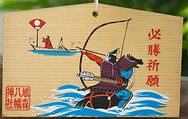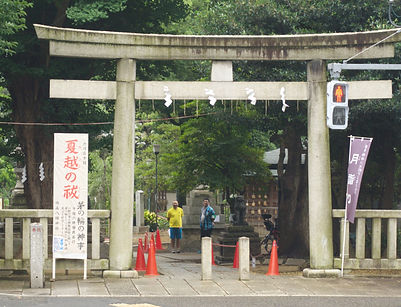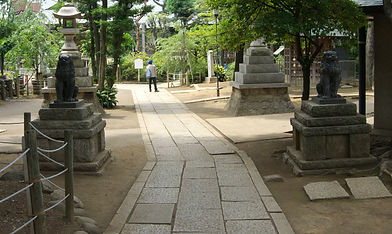普通の外にいくつかの著名な品質を持っている、と畏敬の念を起こさせるあるいかなるビーイングは、カミと呼ばれています。
Nearest station
Kita Sandō
Fukutoshin Line
Tōkyō-to, Shibuya-ku, Sendagaya 1-1-24
東京都渋谷区千駄ヶ谷1-1-24
鳩森八幡神社
Hatonomori Hachiman Jinja
Home page: (Japanese)
July 5. 2017
History
A long time ago in the sky above a woods near the present site of the shrine, auspicious clouds (瑞雲, zui-un) often drifted by. One day when the sky was a clear blue a white cloud descended and the astonished people of the village fled into the woods: as they did this a flock of white doves suddenly took off and flew to the west. The villagers took this as evidence that there was a kami present in the woods and built a hokora there, giving it the name “hato-no-mori,” lit. "dove woods".
Moving into historical times, 860 A.D., the Tendai priest Ennin was on a preaching tour in Kantō and the villagers of Hatonomori entreated him to consecrate a shintai in their hokora: he created statues of Emperor Ōjin, Empress Jingū, and Kasuga Ōkami, enshrined them, thus bestowing true Hachiman credentials on the shrine. Sometime in the Kyūju period (1154-1156), a statue of the Buddhist god Amitābha by a priest called Enshin (恵心) was placed in the reconstructed main building in the spirit of the Honji Suijaku concept.
The shrine was almost entirely destroyed in the fire-bombing of May 26, 1945, and it was not until 1981 that reconstruction
work was finally completed. In 1993 though the main hall was remodelled to something like its original design.
Enshrined Deities:
Main
Emperor Ōjin 応神天王
Empress Jingū 神功皇后
From Merged Shrines
None
In-ground Shrines:
Shinmei-Gū 神明宮
Sengen Jinja 浅間神社
Kōga Inari Sha 甲賀稲荷社
Earliest mention of: 860
Annual Festival: Sept. 15



Description
A little under 500 m from exit #2 of Kitasandō Station, it is one of the The Eight Edo Hachiman-Gū. iIs two most distinctive features are doubtless its Fujizuka, formally known as the Sendagaya Fujizuka, and the Shōgi Hall. Built in 1789, the Fujizuka is said to be the oldest one in Tōkyō, but at 7 m in height it is not particularly big, less than half the size of its counterpart in Shinagawa Jinja. It suffered severe damage in the Great Kantō Earthquake of 1923, but the reconstruction was faithful to the original. Note that in the photo "Peak of Fujizuka - Oku-no-Miya" the donations scattered on the ground in front of the shrine in lack of a donation box are all of just ¥1. The Shōgi Hall is just that, a hall, not a shrine; if it were a shrine the 1.2 m high shōgi piece it houses, shown in the ema above, would. I suppose, be a shintai. The Shōgi Hall was donated to the shrine by the nearby Japan Shogi Association.
(Click on images to expand them)





















